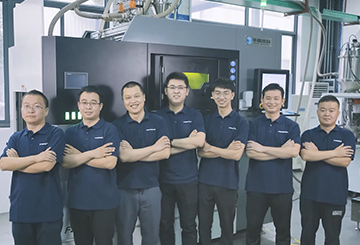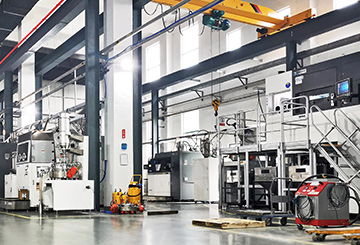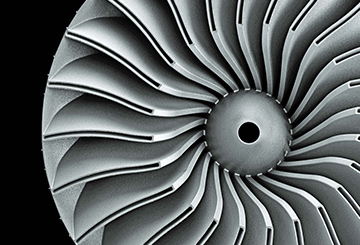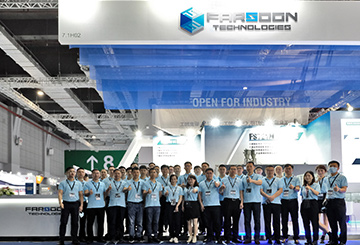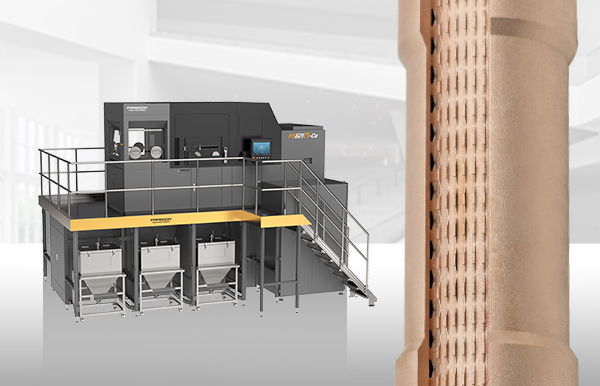We presented this innovation from Farsoon in last year’s edition, but it wasn’t really possible yet to imagine how the Continuous Additive Manufacturing Solution (CAMS) could be implemented.
Farsoon, probably the most important manufacturer of laser sintering machines in China, has made this process an industrial reality within a year. The development partnership between Farsoon and Modellbau Kurz GmbH in Gerlingen near Stuttgart was already announced a year ago. Around the same time, FKM Sintertechnik GmbH also entered into a development partnership with Farsoon. Both companies, independent of each other and with slightly different priorities, have put the machine through its paces.

Figure 1: (Left) Farsoon Headquarter, Changsha China; (Right) Farsoon HT1001P Plastic Laser-Sintering System configured as Continuous Additive Manufacturing System (CAMS)
Both service bureaus have now separately announced the use of Farsoon’s largest laser sintering machine in everyday production. This has encouraged Farsoon to commercialize an adapted configuration of the HT1001P completely.
The Farsoon “Open for Industry” philosophy includes communicating openly about how the beta-tests were carried out and what the results were. For this reason, we invited Christian Blöcher, Managing Director of FKM, Niko Kurz, Head of Additive Manufacturing and co-owner of Modellbau Kurz, and Dr. Dirk Simon, Managing Director of Farsoon Europe, to a joint telephone interview.
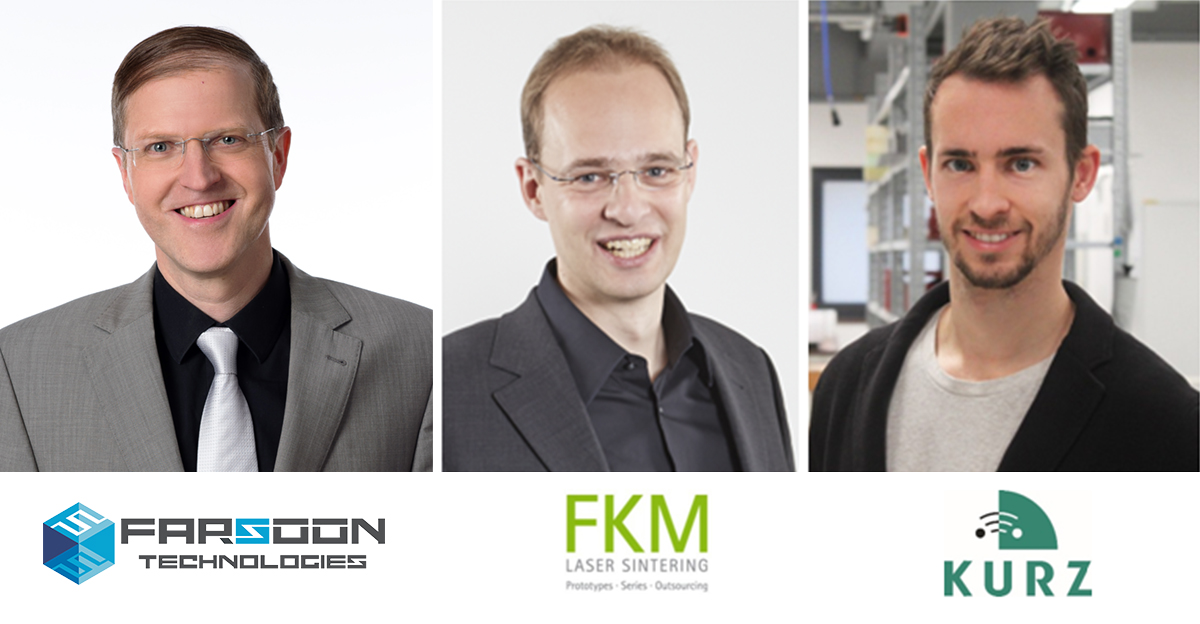
Figure 2: (Left) Dr. Dirk Simon, Managing Director Farsoon Europe GmbH, Stuttgart
(Middle) Mr. Christian Blöcher, Managing Director FKM Sintertechnik GmbH, Biedenkopf
(Right) Niko Kurz, Head of Additive Manufacturing and co-owner of Modellbau Kurz GmbH & Co. KG
Question:
Let’s get started straight away:
With Farsoon’s continuous laser sintering concept, series production is combined with large-volume additive manufacturing. What challenges do you see in this?
Blöcher (FKM): We concentrate on laser sintering because of its high level of industrial maturity. However, we or our customers often assemble or glue parts together in case of large parts. When Farsoon announced the machine with the largest build chamber so far, of course we were interested. We have been working with Farsoon machines for several years now and were therefore confident that the advertised characteristics could reliably be achieved.
Kurz (Modellbau Kurz): The main challenge in integrating series production is automation of the additive manufacturing process (including pre and post-processing). For laser sintering plants, this means, importantly, checking the powder handling, including powder feed, mixing and screening. The HT1001P is equipped with an integrated powder handling system featuring a closed cycle and an increased degree of automation. After further development with the Farsoon team, the powder conveying system is now suitable for robust operation. Further functions such as the breakout station provide user-friendly controls.
Simon (Farsoon): The HT1001P is the first of Farsoon’s systems to be developed according to the CAMS concept, which means that the HT1001P is designed for continuous series production and possesses a modular conveying system. The build cylinder is automatically brought by the loading station into the build zone and then into the cooling station. Together with the automatic powder feed from above, this allows intensive production cycles, while the build cylinders can be changed overnight or at the weekend. With such a large build volume, one meter wide, 50 cm deep and 45 cm high, I consider heat management is a big challenge. The larger the build volume, the longer the powder cake remains at a high temperature. The cooling time increases disproportionately as a result. Therefore, two lasers are used to scan very rapidly, and then cooling is carried out actively in the cooling station.
Question:
You have both beta-tested this new machine. How did it go?
Blöcher: We have had the Farsoon HT1001P in-house since February. The biggest technical challenge at FKM was integrating the machine modules into our powder conveying system and improving the continuous production process. We are impressed by the open exchange of ideas and the implementation by Farsoon. The machine was optimized in all areas: refining some mechanical parts, adding specific control functions, and optimizing software. We are now happy to see that the machine fits very well into our processes and offers a high level of productivity. In addition to the build chamber size, another decisive factor is that after completing a build job, the machine can automatically start a new job, even at night, without needing manual operation.

Figure 3: (Left) FKM Site ind Biedenkopf, Germany; (Right) FKM operates the Farsoon HT1001P Machine
Kurz: It was similar for us. We have a lot of experience with beta-testing, with Objet, Stratasys, HP, and now also with Farsoon. During the beta program, we worked with Farsoon Europe’s local service team on processing PA12, PA12GB and PA6 powders. We learned a lot about how to operate such a large machine and the peripheral devices effectively. On the basis of the test results, we are sure that we can produce good components for commercial use out of PA12 and PA12GB powders using the HT1001P. A couple of months ago, we started using the machine with PA12 powder in normal operation to provide our customers with laser-sintered components.

Figure 4: (Left) Modellbau Kurz Site in Gerlingen; (Right) Mr. Niko Kurz, in front of the Farsoon HT1001P
Question:
Farsoon is headquartered in China and is still quite a young company in Europe. What convinced you to enter into this partnership?
Blöcher: As I already mentioned, we have been working with Farsoon machines for several years. We use them mainly for PA6 parts. In this respect, we are familiar with Farsoon’s software and machine design. Both differ in some aspects from other systems we use. However, the open system approach and the simplicity of the design (in terms of robustness) soon won us over and were key arguments in favor of testing the HT1001P from the start of the year.
Kurz: We visited Farsoon’s headquarters in Changsha last year. We spoke to the research and development team and the top management. They showed us large parts that they had produced for us. That persuaded us. Farsoon seems to be on a solid industrial level that can meet our specific requirements. We also like the philosophy of open material selection and parameter optimization. This opens up business possibilities for specific customer applications. We appreciate Farsoon’s open attitude and the concept of collaboration as equals.
Question:
What was the scope of development, and how did the collaboration with Farsoon go? How do you view the results?
Blöcher: Since this machine is intended for continuous production with minimal downtimes, there was one big challenge: Connecting the machine to our automated powder feed. Farsoon worked with us on this technical integration. It was interesting to see how easily the core team at Farsoon Europe involved the research and development team in Changsha to find pragmatic solutions. This helped us to bring the final HT1001P throughput up to the expected level: A real “powder-eater”.
Kurz: Funny, we call the machine “Powder-Eater”, too! “PE” in fact. Our main objective was processing reinforced plastics, since customers want parts that are comparable with injection-molded PA6 with 30% glass fibers. For this reason, not only did we test PA12, we also started straight away with glass bead-reinforced PA12. That worked very well. Then we purchased specific PA6 materials from third parties and observed problems. PA6 is a more demanding material with a smaller processing window, and it requires a higher temperature. With help from Farsoon and the powder supplier, we were able to optimize a lot, but further development is needed, especially for the production of larger parts. We are still working with Farsoon’s R&D team and the powder supplier to optimize the processing parameters for PA6. But it is possible that the powder also still needs to be optimized.
Simon: Farsoon wanted to know how well this new machine with the novel continuous laser sintering works for the customer. What are the requirements of our customers? Where does the system still need improvement? We would like very specific suggestions resulting from real, practical work with the machine. Without the support of FKM and Modellbau Kurz, we would not have come so far.
Question:
Now that the beta phase of the HT1001P is complete, how can this machine improve the profitability of service bureaus?
Blöcher: The possibility to produce the largest possible functional plastic parts in combination with the ability to produce continuously helps us to increase our capacity noticeably. As service providers, we must expand our capabilities at least as fast as our customers increase their requirements. It’s better for us to stay one step ahead.
Kurz: We have been using the HT1001P commercially since the third quarter of 2019. In this way, our customers can use additive manufacturing for functional components of larger dimensions. Components of up to 1 meter or even larger, if produced diagonally in the build chamber, can now be produced by 3D printing in one piece, which was not possible before. Even when producing smaller lots, we can save considerable costs with the series production capacity of the HT1001P. All these advantages will help our customers to diversify their products and promote the use of 3D-printed components.

Figure 5: Modellbau Kurz fabricates large parts, e.g. automotive grill from PA12 with the HT1001P
Question:
Moving on to servicing, what do you think about ease of maintenance? Is it a critical factor for an innovative system?
Blöcher: Easy servicing should be of central importance for any system. Like other Farsoon systems, the HT1001P has a mechanically simple design, which makes maintenance easier. For example, the exchangeable laser window in the HT1001P is a great idea. We are confident that the good ideas of this machine concept will prove successful.
Kurz: The ease of servicing the system and fast communication with service support are very important to service providers like us. Intensive technical exchange between Farsoon and Modellbau Kurz is crucially important for both sides to drive innovations forward. Our 3D-printing team worked well with Farsoon Europe’s local service team to produce large parts on a daily basis. The HT1001P powder handling system excels thanks to its fully automatic, closed control loop with very easy maintenance.
Question:
What do you think of Farsoon’s time-critical technical support?
Blöcher: When we started collaborating, Farsoon Europe had just put together its local service team. But we always received professional technical support on-site within a short response time, whenever we needed it. We are also glad that Farsoon continues to invest in service and that the local service team in Europe will grow.
Kurz: We have direct contact with the Farsoon Europe service team, and the response speed was always very fast. The proximity of Farsoon Stuttgart to Modellbau Kurz is another big advantage for us. During the beta-testing, the technical team at Farsoon headquarters provided rapid assistance for certain problems.
Simon: It was surprising to me that both companies did not request much service initially, but this increased later. It seemed as though the partners wanted to “play” by themselves at the start. When beta-testing for a broader application was carried out, processing became more difficult, and our rapid technical support ensured that FKM and Modellbau Kurz were able to exploit the advantages of the growing demands fully. This encourages us to continue investing in a customer-centric service system.
Question:
What benefits have you gained from collaboration with Farsoon? How would you rate your relationship with Farsoon?
Blöcher: Farsoon is an important partner for us, since we have seen benefits from the close cooperation. At Farsoon we can feel the strong desire to find the best solutions to all challenges. In combination with Farsoon’s technical capability, this is of critical importance for our progress.
Kurz: From the start, we have built a very good and close relationship with the service technicians and management at Farsoon. During beta-testing, we also received a lot of support from technical management in Changsha and the service engineer at Farsoon Europe. We would like to carry on and continue enjoying this valuable relationship with Farsoon.
Question:
Do you have any further plans with Farsoon?
Blöcher: We certainly do. We have recently ordered our fourth Farsoon system. A glance at Farsoon’s road map shows the ambitious milestones for further industrialization of additive manufacturing. It will definitely be exciting!
Kurz: The HT1001P is the first system from Farsoon that we have introduced. Although this is only the start of our collaboration, we have built a good, stable foundation for strengthening the partnership. The modular construction of the HT1001P makes it easily possible to add future stations for production and to integrate it with existing production lines. We will continue to work with Farsoon, and we are optimistic about what the Farsoon HT1001P will bring us for industrial additive manufacturing.
Simon: We thank FKM and Modellbau Kurz warmly for sharing with us the results of the beta-testing and their experiences using the machine. Having FKM and Modellbau Kurz as the first partners for the HT1001P was a fantastic opportunity for Farsoon. Using the production capacities of the CAMS system together with the manufacturing expertise of FKM and Modellbau Kurz will help pave the way to additive manufacturing. At this year’s Formnext conference, we will launch another two new machines that are waiting for beta partners.
About FKM Sintertechnik:
FKM Sintertechnik is Germany’s pioneer in selective laser sintering and has been part of a revolutionary rethinking process in the industry since 1994. Where the rules of design were once defined by die and mold structures, SLS now changes whole production processes. Complex geometries may now be integrated with components immediately. SLS also means that much fewer steps are needed to produce dynamic assemblies such as immediately functional grippers. Plus, it simplifies design, saves assembly costs and guarantees a long service life. With 20 years of practical experience, FKM has the know-how to take a clear lead.
About Modellbau Kurz:
With 5,500 square meters of production space and a constantly growing technology and machine park, KURZ is a well-known partner to the manufacturing industry. The company possesses numerous processes, surface technologies and expertise in-house for the design, production and development of models and prototypes. Thanks to its investment in the newest technologies on the market, KURZ is a pioneer, especially in the field of industrial 3D printing. Founded in 1972 and headquartered in Gerlingen near Stuttgart, the family business is now run by its third generation. KURZ employs around 80 employees, including highly qualified engineers, designers and modelers.
About Farsoon:
Farsoon Technologies was founded in China in 2009 and is a supplier of industrial-quality plastic laser sintering and metal laser melting systems. Farsoon has assembled a team of world-class experts in electrical and mechanical engineering, lasers, scanning and optics, thermal controls, as well as material development and applications engineering. As a globally diversified company, Farsoon was founded with the clear vision and core objective of creating open platform systems that give the sector the freedom to innovate and expand implementation of additive manufacturing on the global product market.

